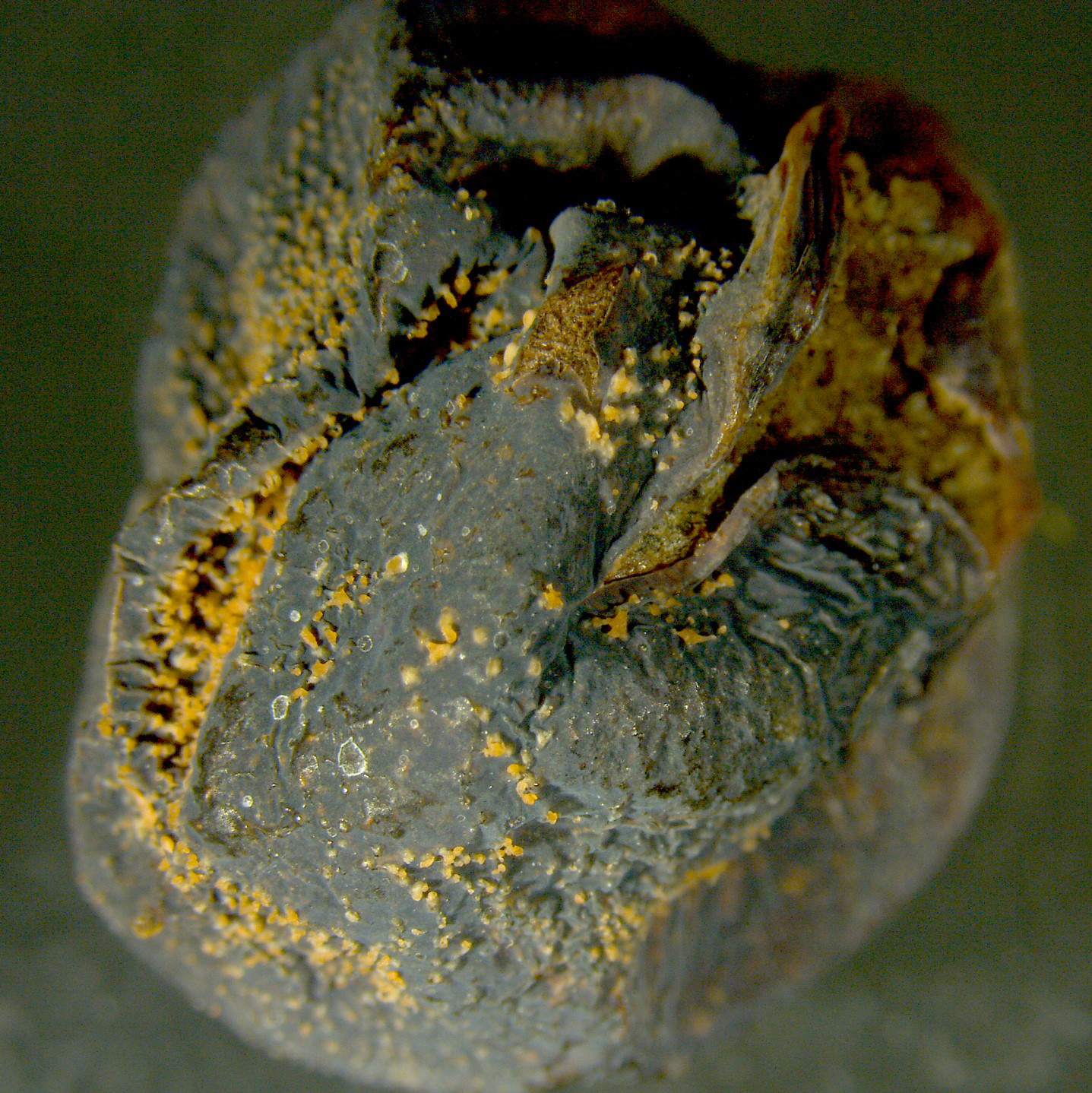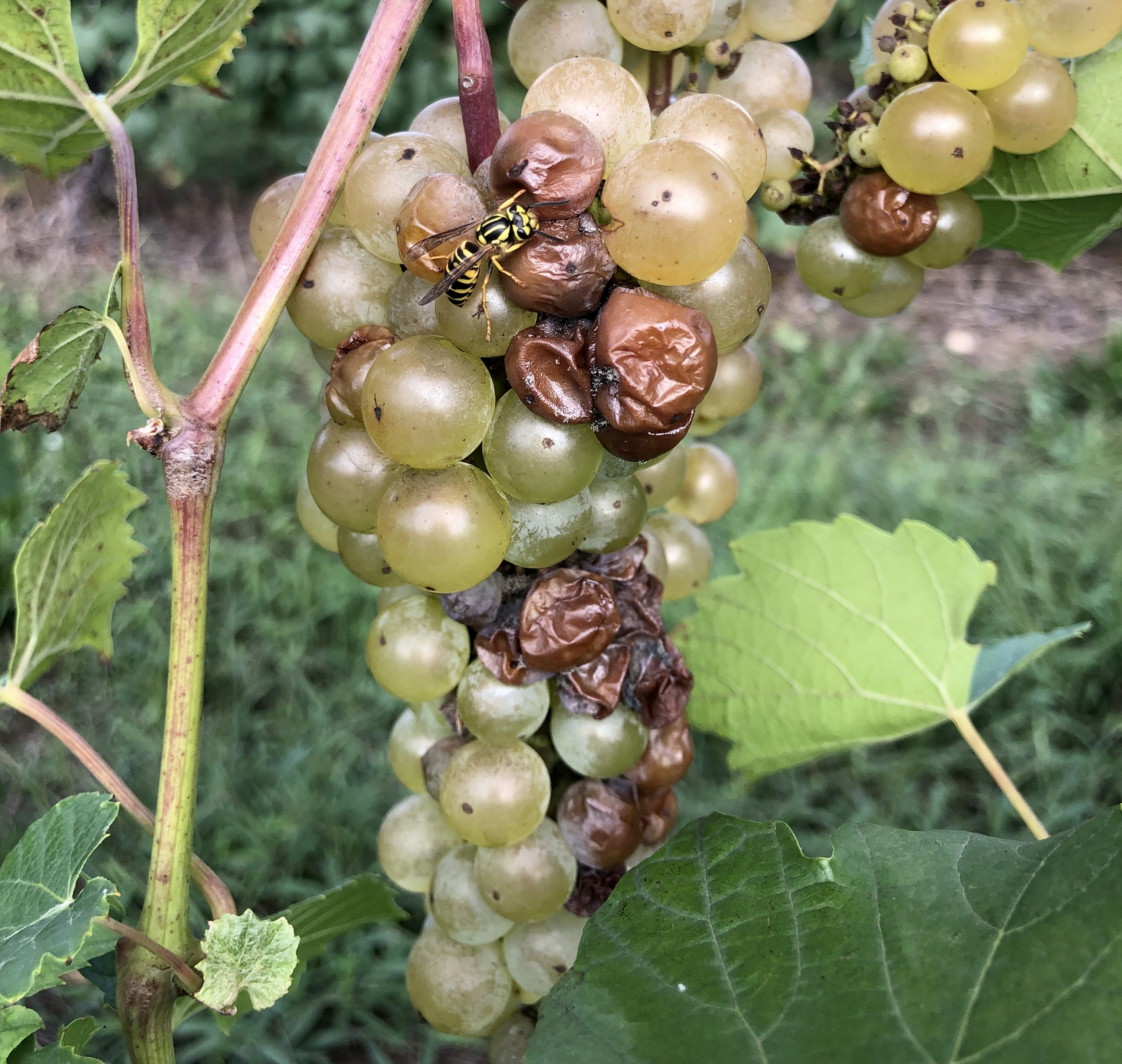Critical practices to control late season grape diseases and the potential effects of fungicides on fermentation
The right strategy for controlling cluster rots is crucial. Be mindful of the preharvest interval when choosing fungicides to manage these grape diseases.

In Michigan, most of the wine grape varieties are approaching or are already within 30 days of the anticipated harvest date. During this period, grape growers face several challenges of managing vineyard nutrient status, fungal diseases and systemic infections that could impair wine quality. The most difficult challenge is always managing cluster rots. In particular, these rots are a problem on several tight clustered cultivars that we are growing in Michigan (e.g., Pinot Noir, Vignoles, Riesling).
Mitigating losses in yield due to bunch rot diseases, such as gray mold (caused by the fungus Botrytis cinerea) and sour rot, is always a problem in a cool and humid environment. Botrytis cinerea initially forms on the surfaces of fruits and infects when natural openings are present on the cluster. These sporulating infections will continue to develop and degrade the fruit leading to a loss of yield.
Also, these infections will compromise quality-related metabolites, such as organic acids, phenolics and volatiles. In Michigan, we often receive high volumes of precipitation during the ripening period and sour rot becomes the more problematic bunch rot disease. The bacteria and yeast comprising the sour rot complex convert the fruit sugars (glucose, fructose) into acetic acid and other metabolites, such as acetaldehyde, galacturonic acid, gluconic acid, ethanol, ethyl acetate and glycerol. Increases in the concentration of acetic acid confer a noticeable vinegar flavor to wines made from these fruits, thus compromising quality and value.
General guidelines
Generally, contact products such as sulfur, copper and captan should be avoided, if possible, if you are within 30-45 days of harvest. Although most of the residual should be gone by harvesting, sulfur and copper may impart off-flavors to wine and captan residues may delay fermentation.
Excess or late application of sulfur in vineyards to combat powdery mildew is the most common cause for a delay in the fermentation process. Yeasts are capable of converting elemental sulfur into H2S, which can cause a rotten egg smell. Residual elemental sulfur in grape must of more than 5 mg/L is likely to cause problems. Consequently, a late sulfur application, particularly if there is no rain between the spray and the harvest, can lead to problematic fermentations. As a result, the rule is not to use sulfur sprays in the vineyard within a few weeks of harvesting. However, while sulfur is a likely culprit, it is not the only cause for problems with fermentation.
The late season copper application can be a concern too. Copper can be toxic to yeast and can cause stress to the yeasts, which may lead to incomplete fermentation, stuck fermentation or defects in the wine aroma. Moreover, bacteria responsible for malolactic fermentation can also be inhibited by a high copper concentration. In conventional viticulture later in the growing season, there are several different fungicide choices for downy mildew control making copper applications not really required.
In order to control a variety of bunch rots as well as downy mildew, some growers use a broad-spectrum contact fungicide like captan. At least 1 mg/L residues of captan can delay primary alcoholic fermentation by 20 to 40 hours, which is long enough to increase the concentration of indigenous microorganisms.
Since newer site-specific products are more targeted in their mode of action, there is less of a chance of them altering the fermentation process. Below are some of the primary disease targets to focus on at this point in the growing season.
Foliar diseases
Downy mildew
The management goal of controlling downy mildew is to maintain a functional canopy through harvest and avoid defoliation. Several cultural practices that increase canopy airflow are particularly helpful at reducing downy mildew infections. If a product is required near harvest, a phosphorous product such as phosphorous acid, Phostrol, ProPhyt etc. has shown mild/moderate efficacy on downy mildew. For site-specific products, it is critical to pay attention to the preharvest interval. Below is a list of your control options:
- 30-day preharvest interval products: Ranman (FRAC 21), Reason (FRAC 11)
- 14-day preharvest interval products: Pristine (FRAC 11 + 7), Abound (FRAC 11), Quadris Top (FRAC 11 + 3), Revus (FRAC 40), Sovran (FRAC 11) and Flint (FRAC 11)
- 0-day pre-harvest interval products: Captan (48-hour reentry interval, FRAC M4), Phosphorus acids (FRAC 33) and Copper (FRAC M1)
Powdery mildew
Several very targeted products are effective against grapevine powdery mildew including Quintec (FRAC 13), Vivando (FRAC 50), Torino (U6) and Gatten (U13), and they have very little effect on other fungi. Other site-specific products such as DMIs (FRAC 3) (e.g., Cevya and Rally) and SDHIs fungicides (FRAC 7) (e.g., Aprovia, and Kenja) are also effective against powdery mildew. Recent surveys in 2018 and 2019 make us believe that FRAC 11 resistance is widespread throughout the state. Use caution when using these products but if isolates are sensitive, they are also effective.
Oil and potassium salt products also have moderate efficacy on powdery mildew, but late applications can decrease sugar accumulation in clusters. All of the above-mentioned chemistries should have limited to no effect on fermentation because their targeted organisms are relatively narrow.
Bunch rots
Botrytis bunch rot
Preharvest is a critical time to control Botrytis on bunch rot-prone cultivars, especially in wet seasons. Early season fungal infections may become active and berries become increasingly susceptible to infection after veraison. (See more notes on disease management of Botrytis). Table 1 lists specific products and the respective preharvest interval (PHI).
|
Table 1. Site-specific products that can be used for Botrytis bunch rot control near harvest. | |||
|---|---|---|---|
|
Trade name |
Active ingredient |
FRAC group |
PHI (days) |
|
Elevate |
fenhexamid |
17 |
0 |
|
Endura |
boscalid |
7 |
14 |
|
Fervent |
Isofetamid + tebuconazole |
7 + 3 |
14 |
|
Flint |
trifloxystrobin |
11 |
14 |
|
Inspire Super |
difenoconazole + cyprodinil |
3 + 9 |
14 |
|
Intuity |
mandestrobin |
11 |
10 |
|
Kenja |
isofetamid |
7 |
14 |
|
Luna Experience |
fluopyram + tebuconazole |
7 + 3 |
14 |
|
Miravis Prime |
pydiflumetofen, fludioxonil |
7 + 12 |
14 |
|
Pristine |
pyraclostrobin + boscalid |
11 + 7 |
14 |
|
Rovral |
iprodione |
2 |
7 |
|
Scala |
pyrimethanil |
9 |
7 |
|
Switch |
cyprodinil and fludioxonil |
9 + 12 |
14 |
|
Vangard |
cyprodinil |
9 |
7 |
Note particularly the FRAC group of these fungicides. If you have been using fungicides from the same FRAC group, you have been using the same type of material all season and you should choose a different FRAC group if the PHI allows you to.
Ripe rot
Ripe rot is caused by Colletotrichum spp. and is known to occur in Michigan. The disease is favored by wet and warm weather conditions after the fruit reach 18 degrees Brix. Typically, this disease is noticed at or just before harvest time.
As the disease progresses in ripening grapes, reddish brown circles develop on the fruit. Control timing for ripe rot is not very clear. Take into consideration that the berries are very susceptible when getting closer to harvest time but infections probably occur much earlier in the season. At this time, fungicide options are minimal and this is still an active area of research.

Sour rot
Sour rot, also known as summer bunch rot, is when the infected grapes crack, ooze and break down, which can be a major concern for fruit and wine quality. While thin-skinned grape varieties are particularly susceptible to this disease, under the right conditions it can strike sensitive grapes.
Latest understanding of sour rot is caused by a combination of yeasts and bacteria, although filamentous fungi may also be associated with rotting berries. The vinegar in rotten berries is emitted by acetic acid forming bacteria, mainly Acetobacter and Gluconobacter species. Managing sour rot involves controlling the microorganisms, Drosophila fruit flies and yellowjacket wasps. Susceptibility is very common to the cultivar when berries reach 15 degrees Brix. Weekly application of insecticides and antimicrobial materials has demonstrated effective management.

Other rots
There are several other rots that affect grapes including bitter rot and anthracnose, each of which are caused by different fungal pathogens. A general rule of thumb is to keep an eye on clusters as fruit ripen. This is particularly important when hail, birds, insects or powdery mildew has damaged the fruit, as wounds serve as entry points for various fungi.
In summary
- Minimize fungicide sprays within one to two weeks before harvest where possible.
- Follow all regulatory preharvest intervals when making any type of fungicide application.
- Do not injure ripening fruit while doing fieldwork like spraying, mowing and controlling insects, birds, etc.
- Increase canopy airflow (e.g., shoot thinning, leaf removal) to decrease environmental conditions favorable to the pathogens.
- Avoid pathogens by harvesting in a timely manner.
- Be aware that bird nets could decrease pesticide penetration into the canopy and cluster zone, therefore choose the right sprayer for effective coverage.
- Vineyard sanitation (e.g., removing old canes, pruning residues and non-harvested clusters) is important for reducing overwintering pests and diseases before the start of the next growing season.



 Print
Print Email
Email